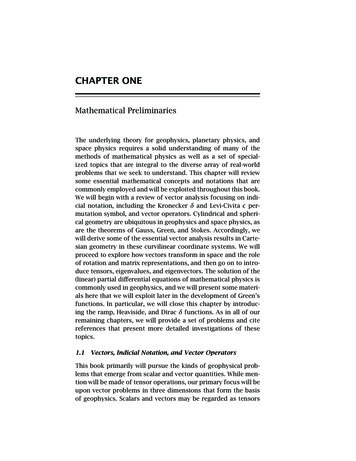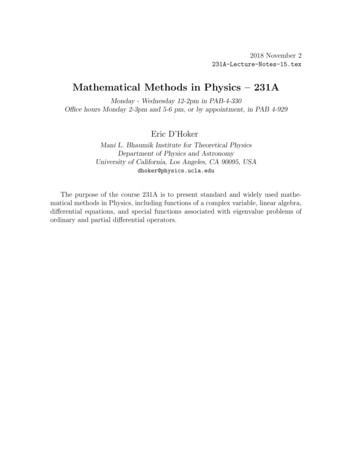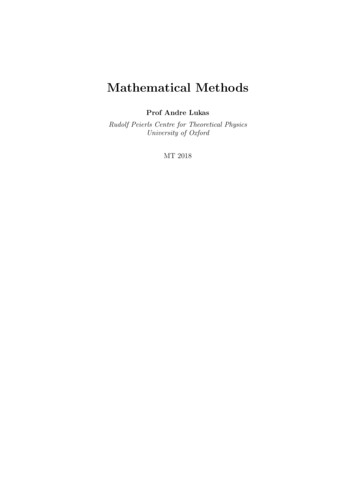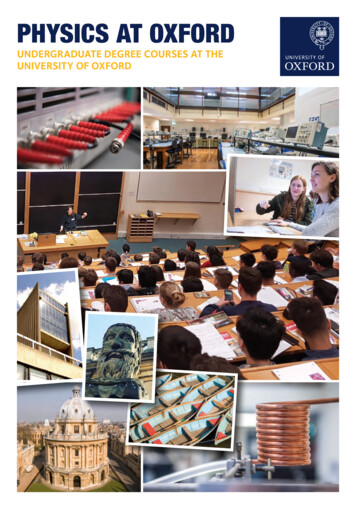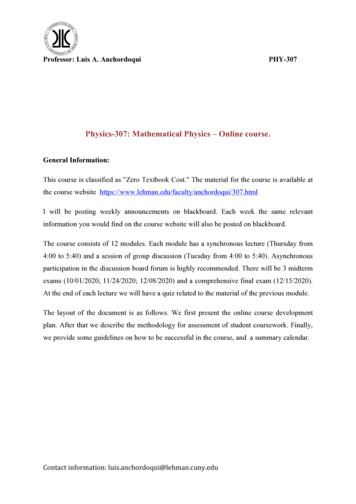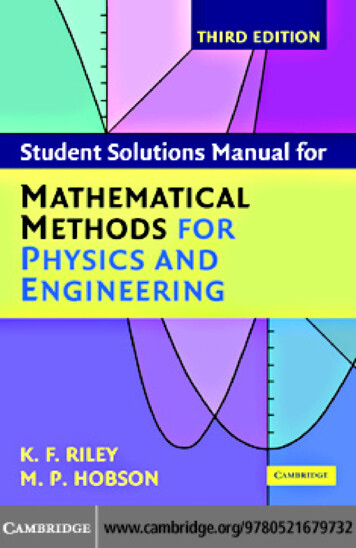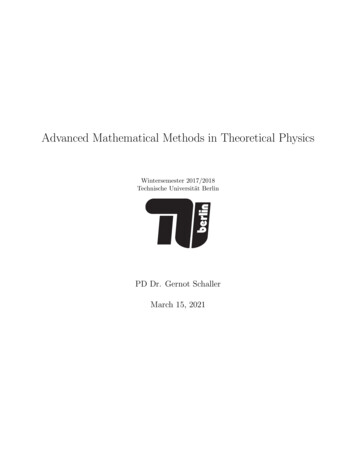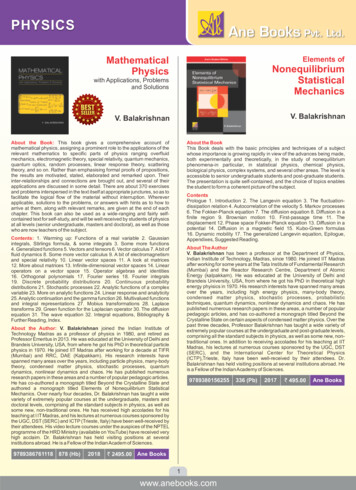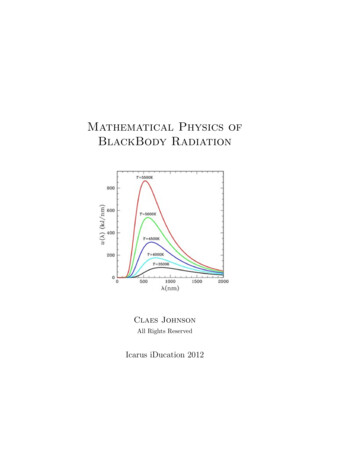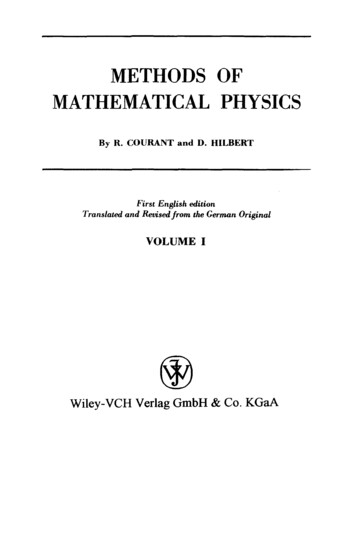
Transcription
METHODS OFMATHEMATICAL PHYSICSBy R. COURANT and D. HILBERTFirst English editionTranslated and Revised from the German OriginalVOLUME IWiley-VCH Verlag GmbH & Co. KGaA
This Page Intentionally Left Blank
METHODS OF MATHEMATICAL PHYSICSVOLUME I
METHODS OFMATHEMATICAL PHYSICSBy R. COURANT and D. HILBERTFirst English editionTranslated and Revised from the German OriginalVOLUME IWiley-VCH Verlag GmbH & Co. KGaA
This Page Intentionally Left Blank
All books published by Wiley-VCH are carehlly produced.Nevertheless, authors, editors, and publisher do not warrant the informationcontained in these books, including this book, to be free of errors.Readers are advised to keep in mind that statements, data, illustrations,procedural details or other items may inadvertently bhe inaccurate.Library of Congress Card Number 53-7164British Library Cataloging-in-Publication Data:A catalogue record for this book is available from the British LibraryBibliographic information published byDie Deutsche BibliothekDie Deutsche Bibliothek lists this publication in the Deutsche Nationalbibliografie;detailed bibliographic data is available in the Internet at http://dnb.ddb.de .Copyright 1937 by Julius Springer, Berlinvested in the Attorney General of the United States, pursuant to law.Manufactured and sold under License A-1 556Copyright 1953 by Interscience Publishers, inc.0 1989 by John Wiley & Sons, Inc.02004 WILEY-VCH Verlag GmbH & Co. KGaA, WeinheimAll rights reserved (including those of translation into other languages).N o part of this book may be reproduced in any form - nor transmitted or translatedinto machine language without written permission from the publishers.Registered names, trademarks, etc. used in this book, even when not specificallymarked as such, are not to be considered unprotected by law.Printed in SingaporePrinted on acid-free paperPrinting and BookbindingMarkono Print Media Pte Ltd, SingaporeISBN-13: 978-0-471-50447-4ISBN-10: 0-47 1-50447-5
PREFACEThe first German edition of this volume was published by JuliusSpringer, Berlin, in 1924. A second edition, revised and improvedwith the help of K. 0. Friedrichs, R. Luneburg, F. Rellich, and otherunselfish friends, followed in 1930. The second volume appeared in1938. In the meantime I had been forced to leave Germany and wasfortunate and grateful to be given the opportunities open in theUnited States. During the Second World War the German book became unavailable and later was even suppressed by the NationalSocialist rulers of Germany. Thus the survival of the book wassecuied when the United States Government seized the copyrightand licensed a reprint issued by Interscience Publishers, New York.Such a license also had to be obtained from the Alien Property Custodian for the present English edition.This edition follows the German original fairly closely but containsa large number of additions and modifications. I have had to postpone a plan to completely rewrite and modernize the book in collaboration with K. 0. Friedrichs, because the pressure for publication ofan English “Courant-Hilbert” has become irresistible. Even so, itis hoped that the work in its present form will be useful to mathematicians and physicists alike, as the numerous demands from allsides seem to indicate.The objective of the book can still today be expressed almost asin the preface to the first German edition. “Since the seventeenthcentury, physical intuition has served as a vital source for mathematical problems and methods. Recent trends and fashions have,however, weakened the connection between mathematics and physics;mathematicians, turning away from the roots of mathematics inintuition, have concentrated on refinement and emphasized the postulational side of mathematics, and a t times have overlooked the unityof their science with physics and other fields. In many cases, physicists have ceased to appreciate the attitudes of mathematicians.This rift is unquestionably a serious threat to science as a whole; thebroad stream of scientific development may split into smaller andV
ViPREFACEsmaller rivulets and dry out. It seems therefore important to directour efforts toward reuniting divergent trends by clarifying the common features and interconnections of many distinct and diversescientific facts. Only thus can the student attain some mastery ofthe material and the basis be prepared for further organic development of research.“The present work is designed to serve this purpose for the field ofmathematical physics. Mathematical methods originating in problems of physics are developed and the attempt is made to shape results into unified mathematical theories. Completeness is not attempted, but it is hoped that access to a rich and important fieldwill be facilitated by the book.“The responsibility for the present book rests with me. Yet thename of my teacher, colleague, and friend, D. Hilbert, on the titlepage seems justified by the fact that much material from Hilbert’spapers and lectures has been used, as well as by the hope that thebook expresses some of Hilbert’s spirit, which has had such a decisiveinfluence on mathematical research and education.”I a m greatly indebted to many helpers in all phases of the task ofpreparing this edition: to Peter Ceike, Ernest Courant, and AnneliLax, who provided most of the first draft of the translation; to HananRubin and Herbert Kranzer, who have given constructive criticism;to Wilhelm Magnus, who is responsible for the appendix to ChapterVII; and to Natascha Artin and Lucile Gardner, who carried theburden of the editorial work. Most cordial thanks also are due toInterscience Publishers for their patient and helpful attitude and t omy old friend and publisher, Dr. Ferdinand Springer in Heidelberg,the great pioneer of modern scientific publishing, for his sympatheticunderstanding of the situation, which has so greatly changed since theold days of our close cooperation.R. COURANTNew Rochelle, New YorkJune 1965
CONTENTSI . The Algebra of Linear Transformations and Quadratic Forms . 1. Linear equations and linear transformations . . . . . . . . . . . . . . . . . . .1 . Vectors . . . . . . . . . . . . . . . . . . . . . . . . . . . . . . . . . . . . . . . . . . . . . . . . . . .2 . Orthogonal systems of vectors . Completeness . . . . . . . . . . . . . .3 . Linear transformations . Matrices . . . . . . .4. Bilinear, quadratic, and Hermitian forms . . . .5. Orthogonal and unitary transformations . . . . . . . . . . . . . . . . . . . 2. Linear transformations with a linesf parameter . . . . . . . . . . . . . . . 3. Transformation t o principal axes of quadratic and Hermitian.forms . . . . . . . . . .1 . Transformatioaxes on the basis of a maximum. . .principle2 . Eigenvalues . . . . . . . . . . . . . . . . . . . . . . . . . . . . . . . . . . . . . . . . . . . . . . .3 . Generalization to Hermitian forms . . . . . . . . . . . . . . . . . . . . . . . .4. Inertial theorem for quadratic farms . . . . . . . . . . . . . . . . . . . . . .5. Representation of the resolvent of a form . . . . . . . . . . . . . . . . .6 . Solution of systems of linear equations associated withforms . . . . . . . . . . . . . . . . . . . . . . . . . . . . . . . . . . . . . . . . . . . . . . . . . . .54. Minimum-maximum property of eigenvslues . . . . . . . . . . . . . . . . . . .1 . Characterization of eigenvalues by a minimum-maximumproblem . . . . . . . . . . . . . . . . . . . . . . . . . . . . . . . . . . . . . . . . . . . . . . . .2 . Applications . Constraints . . . . . . . . . . . . . . . . . . . . . . . . . . . . . . . . .55 . Supplement and problems . . . . . . . . . . . . . . . . . . . . . . . . . . . . . . . . . . . . .1. Linear independence and the Gram determinant . . . . . . . . . .2 . Hadamard’s inequality for determinants . . . . . . . . . . . . . . . . . .3. Generalized t.reatment of canonical transformations . . . . . . . .4. Bilinear and quadratic forms of infinitely many variables . .5. Infinitesimal linear transformations . . . . . . . . . . . . . . . . . . . . . . .6 . Perturbations . . . . . . . . . . . . . . . . . . . . . . . . . . . . . . . . . . . . . . . . . . . .7. Constraints . . . . . . . . . . . . . . . . . . . . . . . . . . . . . . . . . . . . . . . . . . . . . . .8. Elementary divisors of a matrix or a bilinear form . . . . . . . . .9. Spectrum of a uni.I1Series Expansions of Arbitrary Functions . . . . . . . . . . . . . 1 . Orthogonal systems of functions. . . . . . . . . . . . . . . . . . . . . . . . . . . .1 . Definitions . . . . . . . . . . . . . . . . . . . . . . . . . . . . . . . . . . . . . . . . . . .2 . Orthogonalization of functions. . . . . . . . . . . . . . . . . . . . . . . . . .3. Bessel’s inequality . Completeness relation . Approximationin the mean . . . . . . . . . . . . . . . . . . . . . . . . . . . . . . . . . . . . . . . . . . . . 44546474849495051
.CONTENTSVlll4 . Orthogonal and unitary transformations with infinitely.many variables . . . . . . . . . . . .5 . Validity of the results for seindependent variables.More general assumptions6 Construction of complete systems of functions of severalvariables . . . . . . . . . . . . . . . . . . . . . . . . . . . . . 2 The accumulation principle for functions . . . .1. Convergence in function space . . . . . . . . . . 3 Measure of independence and dimension number . . . . . . . . . . . . . .1 . Measure of independence . . . . . . . . . . . . . . . . . . . . . . . . . . . . . . . . .2 Asymptotic dimension of a sequence of functions . . . . . . . . . . 4 Weierstrass’s approximation theorem . Completeness of powersand of trigonometric functions . . . . . . . . . . . . . . . . . . . . .1. Weierstrass’s approximation theorem . . . . . . . . . . . . . . . . . . . . . .2 . ‘Extension to functions of several variables . . . . . . . . . . . . . . . .3 . Simultaneous approximation of derivatives . . . . . . . . . . . . . . . .4 . Completeness of the trigonometric functions . . . . . . . . . . . . . . 5 Fourier series . . . . . . . . . . . . .1. Proof of the fundamental theorem . . . . . . . . . . . . . . . . . . . . . . . .2 . Multiple Fourier series.3 . Order of magnitude of4 . Change in length of ba5 . Examples . . . . . . . . . . . . . 6 The Fourier integral . . . . . . . . . . . . . . . . . . . . . . . . . . . . . . . . . . . . . . . . .1 The fundamental theorem . . . . . . . . . . . . . . . . . . . . . . . . . . . . . . . . .2 Extension.of the result to several variables . . . . . . . . . . . . .3. Reciprocity formulas . . . . . . . . . . . . . . . . . . 7. Examples of Fourier integrals . . . . . . . . . . . . . . . . . . . . . . . . . . . . . . . 8. Legendre polynomials . . . . . . . . . . . . . . . . . . . . . . . . . . . . . . . . . . . . . . . .1. Construction of the Legendre polynomials by orthogonalizaof the powers 1, 5, 21, . . . . . . . . . . . . . . . . . . . . . . . . . . . . . . . . . .2 . The generating function . . . . . . . . . . . . . . . . . . . . . . . . . . . . . . . . . .3. Other properties of the Legendre polynomialR . . . . . . . . . . . . .(a) Recursion formula(b) Differential equation(c) Minimum property69 Examples of other orthogonal systems . .1 Generalizat.ion of the problem leadinomials . . . . . . . . . . . . . . . . . . . . . . . . . .2 Tchebycheff polynomials . . . . . . . . . . . .3. Jacobi polynomials . . . . . . . . . . . . . . . . . .4 . Hermite polynomials . . . . . . . . . . . . . . . . . . . . . . . . . . . . . . . . . . . . . .5 . Laguerre polynomials . . . . . . . . . . . . . . . . . . . . . . . . . . . . . . . . . . . . .6 Completeness of the Laguerre and Hermite functions . . . . . 10. Supplement and problems . . . . . . . . . . . . . . . . . . . . . . . . . . . . . . . . . . .1 . Hurwitz’s solution of the isoperimebric problem . . . . . . . . . . .2 Reciprocity formulas . . . . . . . . . . . . . . . . . . . . . . . . . . . . . . . . . . . . . .3 . The Fourier integral and convergence in the mean . . . . . . . . 282R5A6R787889091939597979898
.111CONTENTSix4 . Spectral decomposition by Fourier series and integrals . . . . .5 . Dense systems of functions . . . . . . . . . . . . . . . . . . . . . . . . . . . . . . . . .6 . A Theorem of H . Muntz on the completeness of powers . . .7 . FejBr’s summation theorem . . . . . . . . . . . . . . . . . . . . . . . . . . . . . . .8. The Mellin inversion formulas. . . . . . . . . . . . . . . . . . . . . . . . . . . .9 . The Gibbs phenomenon . . . . . . . . . . . . . . . . . . . . . . . . . . . . . . . . . . .10. A theorem on Gram’s determinant . . . . . . . . . . . . . . . . . . . . . . . .11. Application of the Lebesgue integral . . . . . . . . . . . . . . . . . . . . . .References . . . . . .99100102102103105107108Linear Integral Equations . . . . . . . . . . . . . . .112 1. Introduction . . . . . . . . . . . . . . . . . . . . . . . . . . . . . . . . . . . . . . . . . . . . . . . . .1121. Not.ation and basic concepts . . . . . . . . . . . . . . . . . . . . . . . . . . . . . . .1122 . Functions in integral representation . . . . . . . . . . . . . . . . . . . . . . .113. . . . . . . . . . . . 1143 . Degenerate kernels . . . . 2. Fredholm’s theorems for d 3. Fredholm’s theorems for arbitrary kernels . . . . . . . . . . . . . . . . . . . . .11804 . Symmetric kernels and their eigenvalues . . . . . . . . . . . . . . . . . . . . . .1221. Existence of an eigenvalue of a symmetric kernel . . . . . . . . . . 1222 . The totality of eigenfunctions and eigenvalues. . . . . . . . . . . . . 1263. Maximum-minimum property of eigenvalues . . . . . . . . . . . . . . 132 5. The expansion theorem and its applications . . . . . . . . . . . . . . . . . . 1341. Expansion theorem . . . . . . . . . . . . . . . . . . . . . . . . . . . . . . . . . . . . . .1342 . Solution of the inhomogeneous linear integral equation . . . . 1363. Bilinear formula for iterated kernels . . . . . . . . . . . . . . . . . . . . . .137. . . . . . . . . . . . . . . . . . 1384 . Mercer’s theorem . . . . . . . . . . . . . . . . . . . 140 6. Neumann series and the 7. The Fredholm formulas . . . . . . . . . . . . . . . . . . . . . . . . . . . . . . . . . . . . . . . 142 8. Another derivation of the theory . . . . . . . . . . . . . . . . .1. A lemma . . . . . . . . . . . . . . . . . . . . . . . . . . . . . . . . . . . . .2 . Eigenfunctions of a symmetric kernel . . . . . . . .3 . Unsymmetric kernels . . . . . . . . . . . . . . . . . . . . . . . . . . . . . . . . . . . . . .1504 . Continuous dependence of eigenvalues and eigenfunctions onthe kernel . . . . . . . . . . . . . . . . . . . . . . . . . . . . . . . . . . . . . . . . . . . . . .151.152 9. Extensions of the theory . . . . . . .153er I11. . . . . . . . . . . . . . . . . . . . . 10. Supplement and problems for C1. Problems . . . . . . . . . . . . . . . . . . . . . . . . . . . . . . . . . . . . . . . . . . 1532 . Singular integral equations . . . . . . . . . . . . . . . . . . . . . . . . . 1543. E . Schmidt’s derivation of the Fredheorems . . . . . . . . . 1554 . Enskog’s method for solving symmetric integral equations . 1565. Kellogg’s method for the determination of eigenfunctions. . 1566. Symbolic functions of a kernel and their eigenvalues. . . . . . . 1577 . Example of an unsymmetric kernel without null solutions . . 1578. Volterra integral equation . .1589 . Abel’s integral equation . .10. Adjoint orthogonal systemkernel . . . . . . . . . . . . . . . . . . . . . . . . . . 159. . . . . . . . . . 15911. Integral equations of the
xCONTENTS16012. Method of infinitely many variables . . . . . . . . . . . . . . . . . . . . . . .16113. Minimum properties of eigenfunctions. . . . . . . . . . . . . . . . . . . . . . . . . . . . . . . . . 16114. Polar integral equations .15. Symmetrizable kernels . . . . . . . . . . . . . . 16116 Determination of the resolvent kernel by functional equations . . . . . . . . . . . . . . . . . . . . . . . . . . . . . . . . . . . . . . . . . . . . . . . . . . . 16216217. Continuity of definite kernels . . . . . . . . . . . . . . . . . . . . . . . . . . . . .18. Hammerstein’s theorem . . .References . . . . . . . . . . . . . . . . . . . . . .IVThe Calculus of Variations . . . .91. Problems of the calculus of variations . . . . . . . . . . . . . . . . . . . . . . . . .1. Maxima and minima of functions . . . . . . . . . . . . . . . . . . . . . . . . . .2. Functionals . . . . . . . . . . . . . . . . . . . . . . . . . . . . . . . . . . . . . . . . . . . . . . .3. Typical problems of the calculus of variations . . . . . . . . . . . . .4. Characteristic difficulties of the calculus of variations . . . . .16416416716917317492. Direct solutions . . . . . . . . . . . . . . . . . . . . . . . . . . . . . . . . . . . . . . . . . . . . . .1 . The isoperimetric problem . . . . . . . . . . . . . . . . . . . . . . . . . . . . . . . .1742 . The Rayleigh-Ritz method . Minimizing sequences . . . . . . . . . 1753 . Other direct methods Method of finite differences. Infinitely many variables . . . . . . . . . . . . . . . . . . . . . . . . . . . . . . . . . .1764 . General remarks on direct methods of the calculus of variations . . . . . . . . . . . . . . . . . . . . . . . . . . . . . . . . . . . . . . . . . . . . . . . . . . .18253 . The Euler equations . . . . . . . . . . . . . . . . . . . . . . . . . . . . . . . . . .1. “Simplest problem” of the variational calculus2 . Several unknown functions . . . . . . . . . . . . . . . . . . . .3 . Higher derivatives . . . . . . . . . . . . . . . . . . . . . . . . . . . . . . . . . . . . . . . .1904 . Several independent variables . . . . . . . . . . . . . . . . . . . . . . . . . . . . .1915 . Identical vanishing of the Euler differential expression . . . . 1936 . Euler equations in homogeneous form . . . . . . . . . . . . . . . . . . . . .196.7. Relaxing of conditions . Theorems of du Bois-Reymond andHaar . . . . . . . . . . . . . . . . . . . . . . . . . . . . . . . . . . . . . . . . . . . . . . . . . . .8 . Variational problems and functional equations . . . . 4. Integration of the Euler.55. Boundary conditions . . . .1. Natural boundary cories . . . . . . . . . .2 . Geometrical problems . Transversality . . . . . . . . . . .96 . The second variation and the Legendre condition . . .57. Variational problems with subsidiary conditions . . . . . . . . . . . . . . .1 . Isoperimetric problems . . . . . . . . . . . . . . . . . . . . . . . . . . . . . . . . . . . .2 . Finite subsidiary conditions .3. Differential equations as subsidiary conditions . . . . . . . . . . . . .98. Invariant character of the Euler equations .1. The Euler expression as a gradient in function space . Invariance of the Euler expression . . . . . . . . . . . . . . . . . . . . . . . . .2 . Transformation of Au . Spherical coordinates . . . . . . . . . . . . . . .3 . Ellipsoidal coordinates . . . . . . . . . . . . . . . . . . . . . . . . . . . . . . . . . . . .199205206208208211214216216219221222222224226
CONTENTSXI 9. Transformation of variational problems to canonical and involutory form . . . . . . . . . . . . . . . . . . . . . . . . . . . . . . . . . . . . . . . . . . . . . .2311 . Transformation of an ordinary minimum problem with subsidiary conditions . . . . . . . . . . . . . . . . . . . . . . . . . . . . . . . . . . . . . . . 2312 . Involutory transformation of the simplest variational problems . . . . . . . . . . . . . . . . . . . . . . . . . . . . . . . . . . . . . . . . . . . . . .3 . Transformation of variational problems to ca4 . Generalizations . . . . . . . . . . . . . . . . . . . . . . . . . . . . . 10. Variational calculus and the differential equations of mathe. . . . . . . . . . . . . . . . . . . 242matical physics . . . . . . . . . . . .1 . General remarks . . . . . . . . .242ating rod . . . . . . . . . . . . . . . . 2442 . The vibrating string and2463 . Membrane and plate . . . . . . . . . . . . . . . . . . . . . . . . . . . . . . . . . . . . . .511. Reciprocal quadratic variational problems . . . . . . . . . . . . . . . . . . . .252257 12. Supplementary remarks and exercises . . . . . . . . . . . . . . . . . . . . . . . . .1. Variational problem for a given differential equation . . . . . . 2572582 . Reciprocity for isoperimetric problems . . . . . . . . . . . . . . . . . . . .2583 . Circular light rays4 . The problem of Dido . . . . . . . . . . . . . . . . . . . . . . . . . . . . . . . . . . . . . 2585 . Examples of problems in space . . . . . . . . . . . . . . . . . . . . . . . . . . . .2582586 . The indicatrix and applications . . . . . . . . . . . . . . . . . . . . . . . . . . .2607 . Variable domains . . . . . . . . . . . . . . . . . . . . . . . . . . . . . . . . . . . . . . . . .8 . I3. Noether’s theorem on invariant variational problems .Integrals in particle mechanics . . . . . . . . . . . . . . . . . . . . . . . . . . 2629 . Transversality for multiple integrals . . . . . . . . . . . . . . . . . . . . .26610. Euler’s differential expressions on surfaces . . . . . . . . . . . . . . . . . 26711 . Thomson’s principle in electrostatics . . . . . . . . . . . . . . . . . . . . . .26712. Equilibrium problems for elastic bodies . Castigliano’s principle . . . . . . . . . . . . . . . . . . . . . . . . . . . . . . . . . . . . . . . . . . . . . . . . . . . . 26813. The variational problem of buckling . . . . . . . . . . . . . . . . . . . . . . 272References . . . . . . . . . . . . . . . . . . . . . . . . . . . . . . . . . . . . . . . . . . . . . . . . . . . . . . . .274V.Vibration and Eigenvalue Problems . . . . . . . . . . . . . . . . . . . . . . . . . . . . .275\ 1 . Preliminary remarks about linear differential equations . . . . . . . 2751. Principle of superposition . . . . . . . . . . . . . . . . . . . . . . . . . . . . . . . . . 2752 . Homogeneous and nonhomogeneous problems . Boundaryconditions . . . . . . . . . . . . . . . . . . . . . . . . . . . . . . . . . . . . . . . . . . . . . .2773. Formal relations . Adjoint differential expressions . Green’s277formulas . . . . . . . . . . . . . . . . . . . . . . . . . . . . . . . . . . . . . . . . . . . . . . .4 . Linear functional equations as limiting cases and analoguesof systems of linear equations . . . . . . . . . . . . . . . . . . . . . . . . . . .28042 . Systems of a finite number of degrees of freedom . . . . . . . . . . . . . 2811 . Normal modes of vibration . Normal coordinates . Generaltheory of motion . . . . . . . . . . . . . . . . . . . . . . . . . . . . . . . . . . . . .2822 . General properties of vibrating systems . . . . . . . . . . . . . . . . . 28528643 . The vibrating string . . . . . . . . . . . . . . . . . . . . . . . . . . . . . . . . . . . . . . . . . .1. Free motion of the homogeneous string . . . . . . . . . . . . . . . . . . . .287
xiiCONTENTS2. Forced motion . . . . . . . . . . . . . . . . . . . . . . . . . . . . . . . . . . . . . . . . . . . .3. The general nonhomogeneous string and the Sturm-Liouville eigenvalue problem. . 4.The vibrating rod. . . . . . . . . . . . 5. The vibrating membrane. . . . .1. General eigenvalue proble2. Forced motion. . . . . . . . . .3. Nodal lines. . . . . . . . . . . . .4. Rectangular membrane . .5 . Circular membrane. Bessel functions. .6. Nonhomogeneous membrane. . . . . . . . . . . . . . . . . . . . . . . . . . . . . . . 6. The vibrating plate. . . . . . . . . . .1. General remarks. . . . . . . . . . . . . . . .2. Circular boundary. . . . . . . . . . . . . . . . . . . . 7. General remarks on the eigenfunction method. . . . . . . . . . . . . . . .1. Vibration and equilibrium problems. .2. Heat conduction and eigenvalue problems. . . . . . . . . . . . . . . . 8. Vibration of three-dimensional continua. Separation of variables . 9. Eigenfunctions and the boundary value problem of potentialtheory. .1. Circle, sphere, and spherical shell. . . . . . . . . .2. Cylindrical domain. . . . . . . . . . . . . . . . . . . . . . . . . . . . . . . . . . . . . . .3. The Lam6 problem. . . 10. Problems of the Sturm-Liouville type. Singular boundarypoints . . . . . . . . . . . . . . . . . . . . . . . . . . . . . . . . . . . . . . . . . . . . . . . . . . . . . .1. Bessel functions. .2. Legendre function.3. Jacobi and Tchebycheff polynomials. . . .4. Hermite and Laguerre polynomiai l l . The asymptotic behavior of the solequations. . . . . . . . . . . . . . . . . . . . . . . . . . . . . . . . . . . . . . . . . . . . . . . . . . .1. Boundedness of the solution as the independent variable3. Boundedness as the parameter 12. Eigenvalue problems with a 331. . . . . . . . . . 332. . . . . . . . . . . . . . . . . . . 334. . . . . . . . . . 335. . . . . . . . 339. . . . . . . . 340. . . . . . . . . . . . . . . . . 341
.CONTENTSXlll1. Simple eigenvalues . . . . . . . . . . . . . . . . . . . . . . . . . . . . . . . . . . . . . . . .3442 . Multiple eigenvalues . . . . . . . . . . . . . . . . . . . . . . . . . . . . . . . . . . . . .3463 . An example . . . . . . . . . . . . . . . . . . . . . . . . . . . . . . . . . . . . . . . . . . . . . .348 14. Green’s function (influence function) and reduction of differential equations t o integral equations . . . . . . . . . . . . . . . . . . . . . . . . . 3511 . Green’s function and boundary value problem for ordinarydifferential equations . . . . . . . . . . . . . . . . . . . . . . . . . . . . . . . . .3512 . Construction of Green’s functian; Green’s function in thegeneralized sense . . . . . . . . . . . . . . . . . . . . . . . . . . . . . . . . . . . . . . . . 3543 . Equivalence of integral and differential equations . . . . . . . . . 3584 . Ordinary differential equations of higher order . . . . . . . . . . . . 3625 . Partial differential equations . . . . . . . . . . . . . . . . . . . . . . . . . . . . .36‘ 15. Examples of Green’s function . . . . . . . . . . . . . . . . . . . . . . . . . . . . . . . . .3111 . Ordinary differential equations . . . . . . . . . . . . . . . . . . . . . . . . . . . .3712 . Green’s function for Au: circle and sphere . . . . . . . . . . . . . . . . . 3773 . Green’s function and conformal mapping . . . . . . . . . . . . . . . . . . 3774 . Green’s function for the potential equation on the surface378of a sphere . . . . . . . . . . . . . . . . . . . . . . . . . . . . . . . . . . . . . . . . . . . .5. Green’sfunction for Au 0 i n a rectangular parallelepiped . 3786 . Green’s function for A u in the int.erior of a rectangle . . . . . . 3847 . Green’s function for a circular ring . . . . . . . . . . . . . . . . . . . . .386.388 16. Supplement t o Chapter V .1 . Examples for the vibrating string. . . . . . . . . . . . . . . . . 3882 . Vibrations of a freely suspended ressel functions . . . . 3903 . Examples for the explicit solution of the vibration equa.tion . Mathieu functions . . . . . . . . . . . . . . . . . . . . . . . . . . . . . . . . . 3913924 . Boundary conditions with parameters . . . . . . . . . . . . . . . . . . . .5 . Green’s tensors for systems of differential equations . . . . . . 3936 . Analytic continuation of the solutions of the equationAuXu 0 . . . . . . . . . . . . . . . . . . . . . . . . . . . . . . . . . . . . . . . . . . .3957 A theorem on the nodal curves of the solutions of Auxu 0 . . . . . . . . . . . . . . . . . . . . . . . . . . . . . . . . . . . . . . . . . . 3958 . An example of eigenvalues of infinite multiplicity . . . . . . . . . 3959 . Limits for the validity of the expansion theorems . . . . . . . . . 395Rejerences . . . . . . . . . . . . . . .396.VI Application of the Calculus of Variations to Eigenvalue Problems . . 397 1 . Extremum properties of eigenvalues . . . . . . . . . . . . . . . . . . . . . . . .1 . Classical extremum properties . . . . . . . . . . . . . . . . . . . . . . . .2 . Generalizations . . . . . . . . . . . . . . . . . . . . . . . . . . . . . . . . . . . . . . . . . .3 . Eigenvalue problems for regions with separate components .4 . The maximum-minimum property of eigenvalues . . . . . . . . . . . 2. General consequences of the extremum properties of the eigenvalues . . . . . . . . . . . . . . . . . . . . . . . . . . . . . . . . . . . . . . . . . . . . . . . . . . . . . .1. General theorems . . . . . . . . . . . . . . . . . . . . . . . . . . . . . . . . . . . . . . . .398398402405405407407
xivCONTENTS2 . Infinite growth of the eigenvalues .4123 . Asymptotic behavior of the eigenvalues in the Sturm-Liouville problem.4144 . Singular differential equations . . . . . . . . . . . . . . . . . . . . . . . . . . . . .4155 . Further remarks concerning the growth of eigenvalues .Occurrence of negative eigenvalues .416. 4186 . Continuity of eigenvalues .53. Completeness and expansion theorems . . . . . . . . . . . . . . . . . . . . . . . .4241. Completeness of the eigenfunctions . . . . . . . . . . . . . . . . . . . . . . . .4242. The expansion theorem .4263. Generalizatio
mathematical physics. Mathematical methods originating in prob- lems of physics are developed and the attempt is made to shape re- sults into unified mathematical theories. Completeness is not at- tempted, but it is hoped that access to a rich and important field will be facilitated by the book. .

